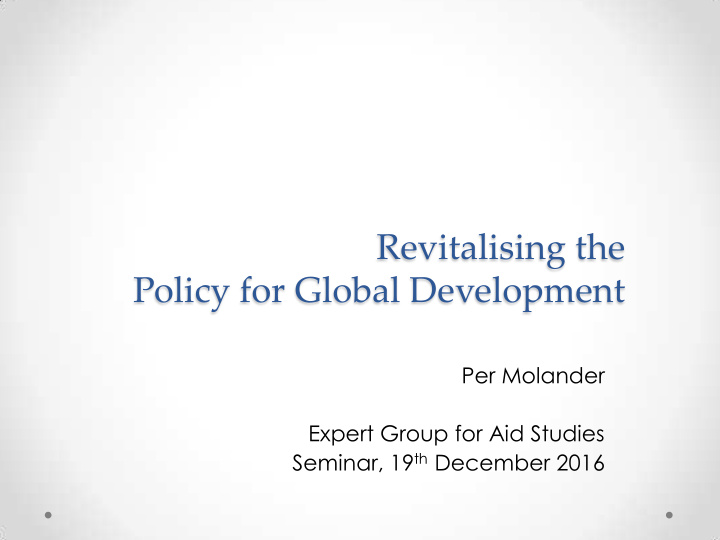



Revitalising the Policy for Global Development Per Molander Expert Group for Aid Studies Seminar, 19 th December 2016
Purposes of the study • Survey of social-science literature on development: What do we know? • Policy conclusions for a small, non-aligned country like Sweden: What should be in focus for development cooperation?
Knowledge base: improving, but important weaknesses remain Improvements • Data supply has improved • New methods in causal analysis Weaknesses • Data quality • Poverty, illiteracy, poor health services are underreported • Integrity of basic statistical services and audit institutions
Main themes of the study • Growth • State-building • Inclusive development
Growth Theories of economic growth: • Capital and labour • Technology • Human capital (endogenous growth) • Institutions: constitutional design, quality of government • Natural conditions • Trade The Singer-Prebisch hypothesis partly confirmed: de-industrialisation, inequality, volatility
State-building Institutions matter constitutional design • middle-range: budgetary institutions • micro-level: accounting, transparency • Education and collective goods individual autonomy, female emancipation • productivity • crime, corruption, conflict • Scope of the state the Washington Consensus • core functions: public administration, education, health • care tax revenues •
Inclusive development Main justification: market drift towards inequality Dimensions of inequality • land • gender • education No inherent conflict between equality and growth • equality of opportunity fosters growth • some equalisation of outcomes is necessary
Long-term distribution in a market economy is starkly unequal Left curve Gini coefficient, right curve share of total assets for (from the top) the richest1%, 1-5%, and 5-10%, respectively. Source : Fernholz & Fernholz, J. Econ. Dyn. & Control 44, 251-269 (2014).
Stylised facts for policy development Aid works on average but could be more efficient. • Low-growth traps require a joint effort in several fields. • A strong, well-functioning state is central to • development. Developing countries are under-taxed. • Education is of key importance: • - individual autonomy - political maturity - female emancipation - productivity - crime - reduced corruption. The international trade system is biased in favour of rich • countries.
Swedish bilateral aid: current priorities Other Budget support 19 Education Democracy, human rights Other purposes 621 603 and gender equality Agriculture and forestry 627 652 Environment and climate 5529 670 Conflict, peace and security 718 855 Research 972 Market development 1469 2970 Health 2089 Humanitarian aid Sustainable built environment
Policy conclusions Policy for Global Development: • Trade policy : adapt the international trade regime to the needs of developing countries • International tax cooperation : curb tax evasion (both physical persons and corporations) • Coordinate the PGD from the Prime Minister’s Office Bilateral development cooperation: • Concentrate efforts sector-wise and geographically • Upgrade support to the educational sector • Upgrade support to public-administration capacity building
A way forward
Recommend
More recommend